CHEVROLET BLAZER 1995 2.G Owner's Guide
Manufacturer: CHEVROLET, Model Year: 1995, Model line: BLAZER, Model: CHEVROLET BLAZER 1995 2.GPages: 380, PDF Size: 20.04 MB
Page 31 of 380
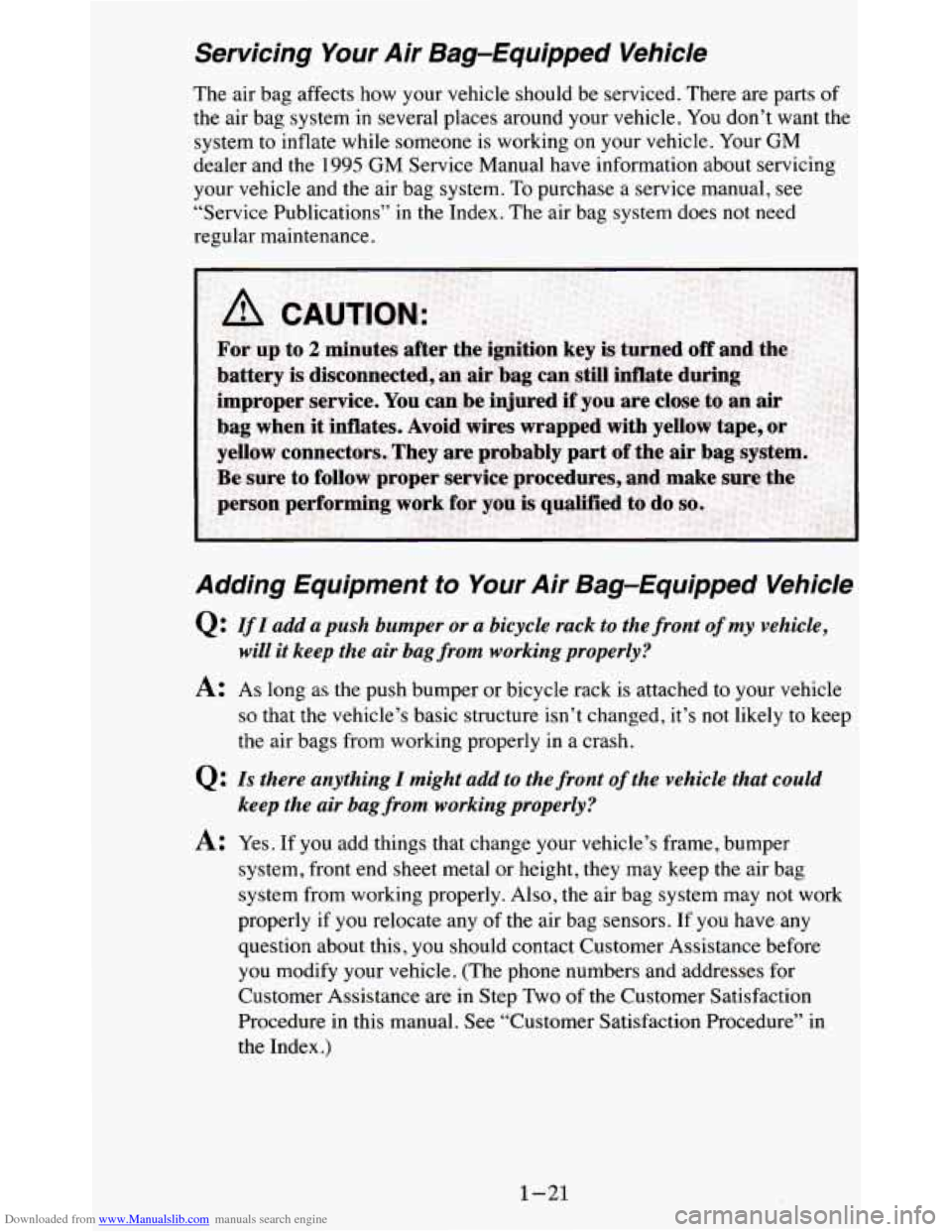
Downloaded from www.Manualslib.com manuals search engine Servicing Your Air Bag-Equipped Vehicle
The air bag affects how your vehicle should be serviced. There are parts of
the air bag system
in several places around your vehicle. You don’t want the
system to inflate
while someone is working on your vehicle. Your GM
dealer and the 1995 GM Service Manual have information about servicing
your vehicle and the air bag system.
To purchase a service manual, see
“Service Publications”
in the Index. The air bag system does not need
regular maintenance.
Adding Equipment to Your Air Bag-Equipped Vehicle
Q : If I add a push bumper or a bicycle rack to the front of my vehicle,
A: As long as the push bumper or bicycle rack is attached to your vehicle
will it keep the air bag from working properly?
so that the vehicle’s basic structure isn’t changed, it’s not likely to keep
the air bags from working properly
in a crash.
0: Is there anything I might add to the front of the vehicle that could
keep
the air bag from working properly?
A: Yes. If you add things that change your vehicle’s frame, bumper
system, front end sheet metal or height,
they may keep the air bag
system from working properly. Also, the air bag system may not work
properly if
you relocate any of the air bag sensors. If you have any
question about this, you should contact Customer Assistance before
you modify your vehicle. (The phone numbers and addresses for
Customer Assistance are
in Step Two of the Customer Satisfaction
Procedure in this manual. See “Customer Satisfaction Procedure” in
the Index
.)
1-21
Page 32 of 380
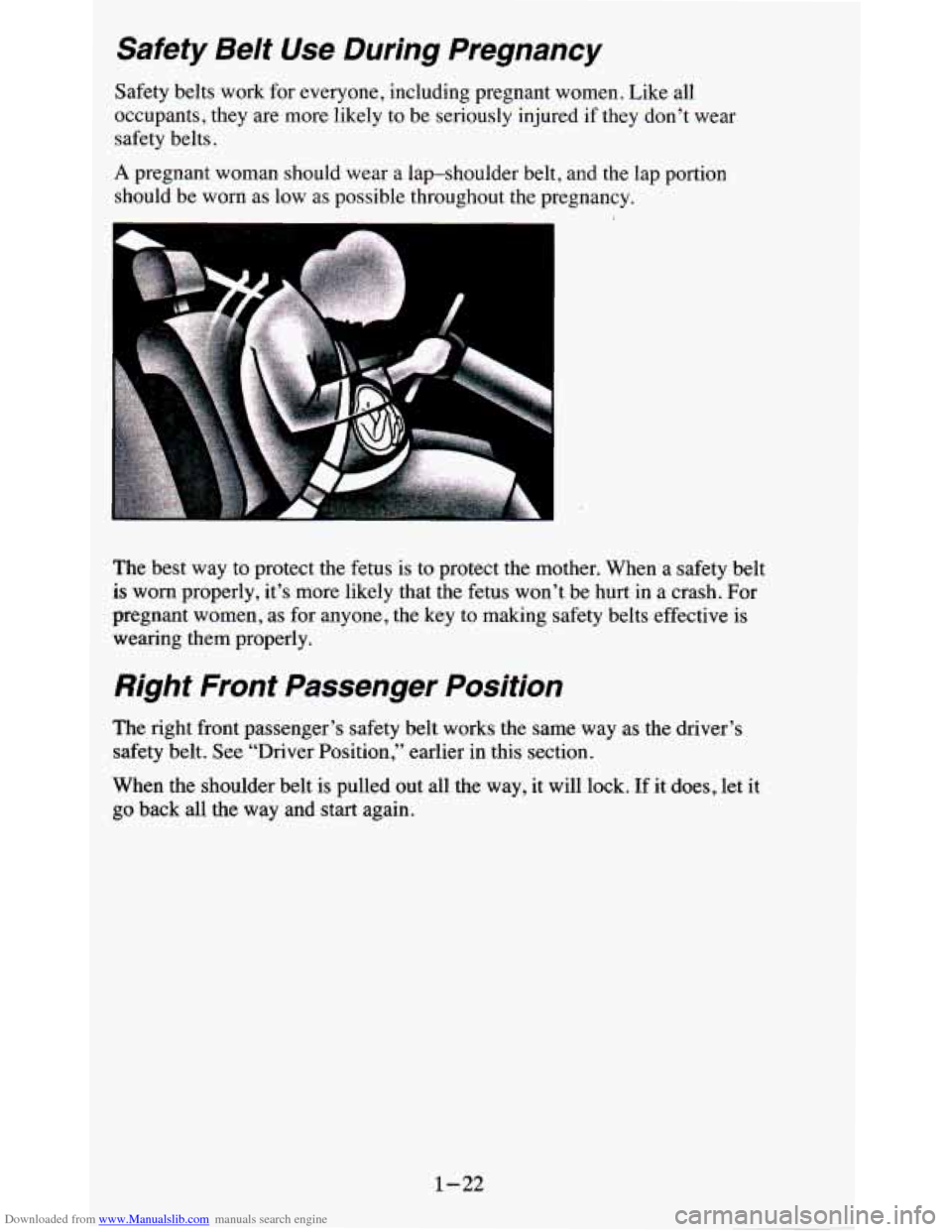
Downloaded from www.Manualslib.com manuals search engine Safety Belt Use During Pregnancy
Safety belts work for everyone, including pregnant women. Like all
occupants, they are more likely to be seriously injured if they don’t wear
safety belts.
A pregnant woman should wear a lap-shoulder belt, and the lap portion
should be worn
as low as possible throughout the pregnancy.
The best way
to protect the fetus is to protect the mother. When a safety belt
is worn properly, it’s more likely that the fetus won’t be hurt in a crash. For
pregnant women, as for anyone, the key to making safety belts effective
is
wearing them properly.
Right Front Passenger Position
The right front passenger’s safety belt works the same way as the driver’s
safety belt. See “Driver Position,” earlier in this section.
When the shoulder belt
is pulled out all the way, it will lock. If it does, let it
go back all the way and start again.
1-22
Page 33 of 380
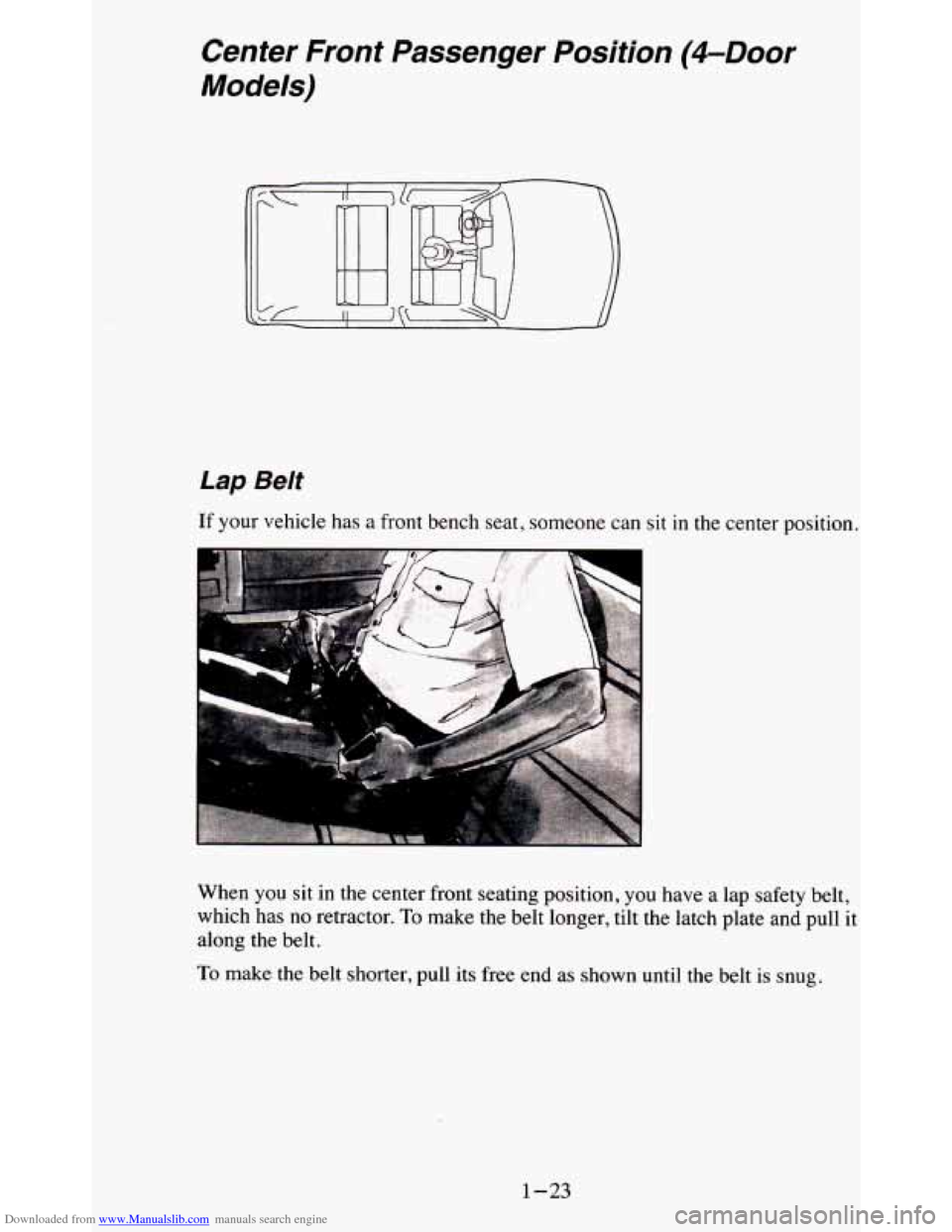
Downloaded from www.Manualslib.com manuals search engine Center Front Passenger Position (4-Door
Models)
Lap Belt
If your vehicle has a front bench seat, someone can sit in the center position.
When
YOU sit in the center front seating position, you have a lap safety belt,
which has
no retractor. To make the belt longer, tilt the latch plate and pull it
along the belt.
TO make the belt shorter, pull its free end as shown until the belt is snug.
1-23
Page 34 of 380
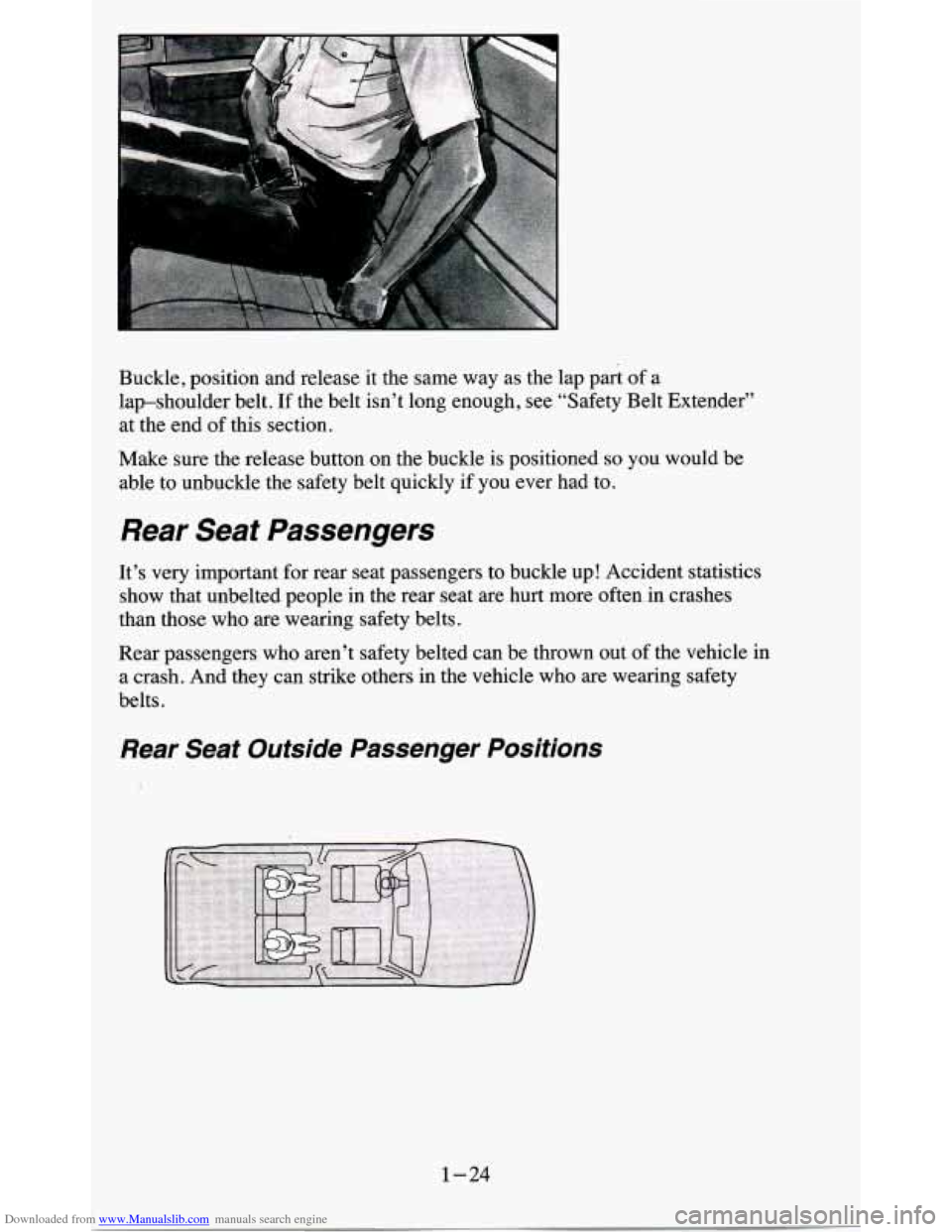
Downloaded from www.Manualslib.com manuals search engine Buckle, position and release it the same way as the lap part of a
lap-shoulder belt.
If the belt isn’t long enough, see “Safety Belt Extender”
at the end of this section.
Make sure the release button on the buckle is positioned
so you would be
able to unbuckle the safety belt quickly if you ever had to.
Rear Seat Passengers
It’s very important for rear seat passengers to buckle up! Accident statistics
show that unbelted people in the rear seat are hurt more ofte\
n in crashes
than those who are wearing safety belts.
Rear passengers who aren’t safety belted can be thrown out of the vehicle in
a crash. And they can strike others in the vehicle who are wearing safety
belts.
Rear Seat Outside Passenger Positions
1-24
Page 35 of 380
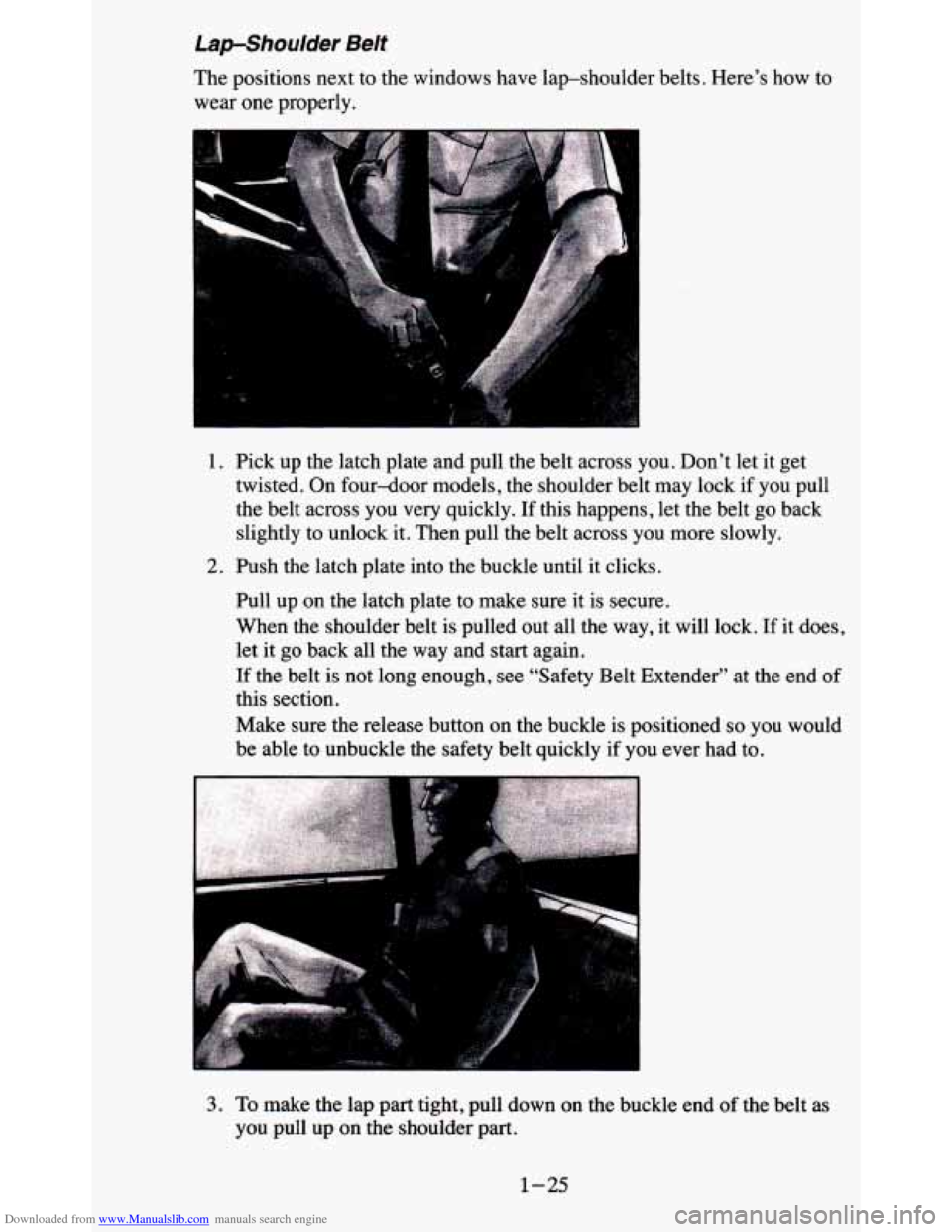
Downloaded from www.Manualslib.com manuals search engine Lapshoulder Belt
The positions next to the windows have lap-shoulder belts. Here’s how to
wear one properly.
1. Pick up the latch plate and pull the belt across you. Don’\
t let it get
twisted. On four-door models, the shoulder belt may lock if you pull
the belt across you very quickly. If this happens, let the belt go back
slightly to unlock it. Then pull the belt across you more slowly.
2. Push the latch plate into the buckle until it clicks.
Pull up on the latch plate to make sure it is secure.
When the shoulder belt
is pulled out all the way, it will lock. If it doesr
let it go back all the way and start again.
If the belt
is not long enough, see “Safety Belt Extender’’ at the end of
this section.
Make sure the release button on the buckle is positioned
so you would
be able
to unbuckle the safety belt quickly if you ever had to.
3. To make the lap part tight, pull down on the buckle end of the belt as
you pull up on the shoulder part.
1-25
Page 36 of 380
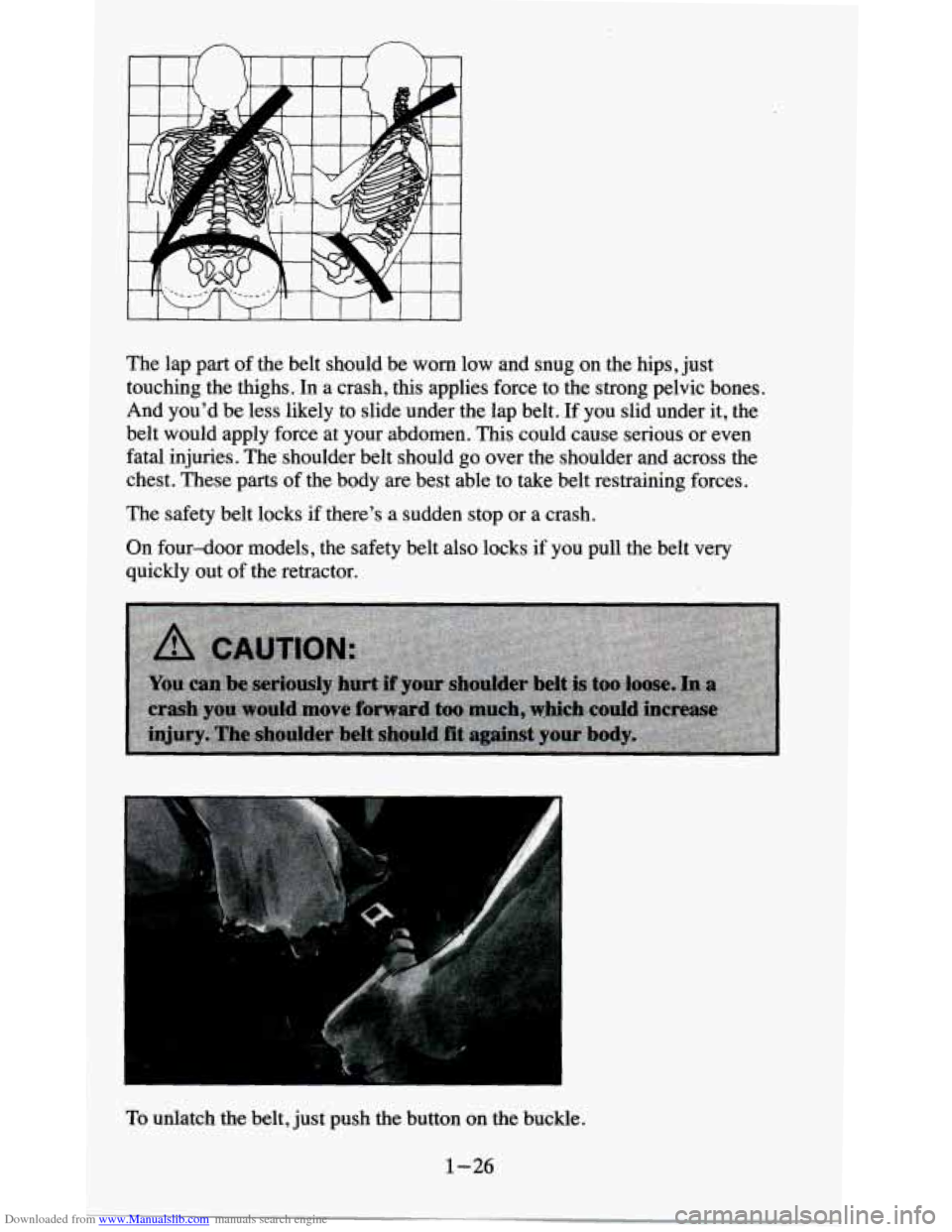
Downloaded from www.Manualslib.com manuals search engine I I It
The lap part of the belt should be worn low and snug on the hips, just
touching the thighs. In a crash, this applies force to the strong pelvic bones.
And you’d be less likely to slide under the lap belt.
If you slid under it, the
belt would apply force at your abdomen. This could cause serious or even
fatal injuries. The shoulder belt should
go over the shoulder and across the
chest. These parts of the body are best able to take belt restraining forces.
The safety belt locks
if there’s a sudden stop or a crash.
On four-door models, the safety belt also locks
if you pull the belt very
quickly out
of the retractor.
Page 37 of 380
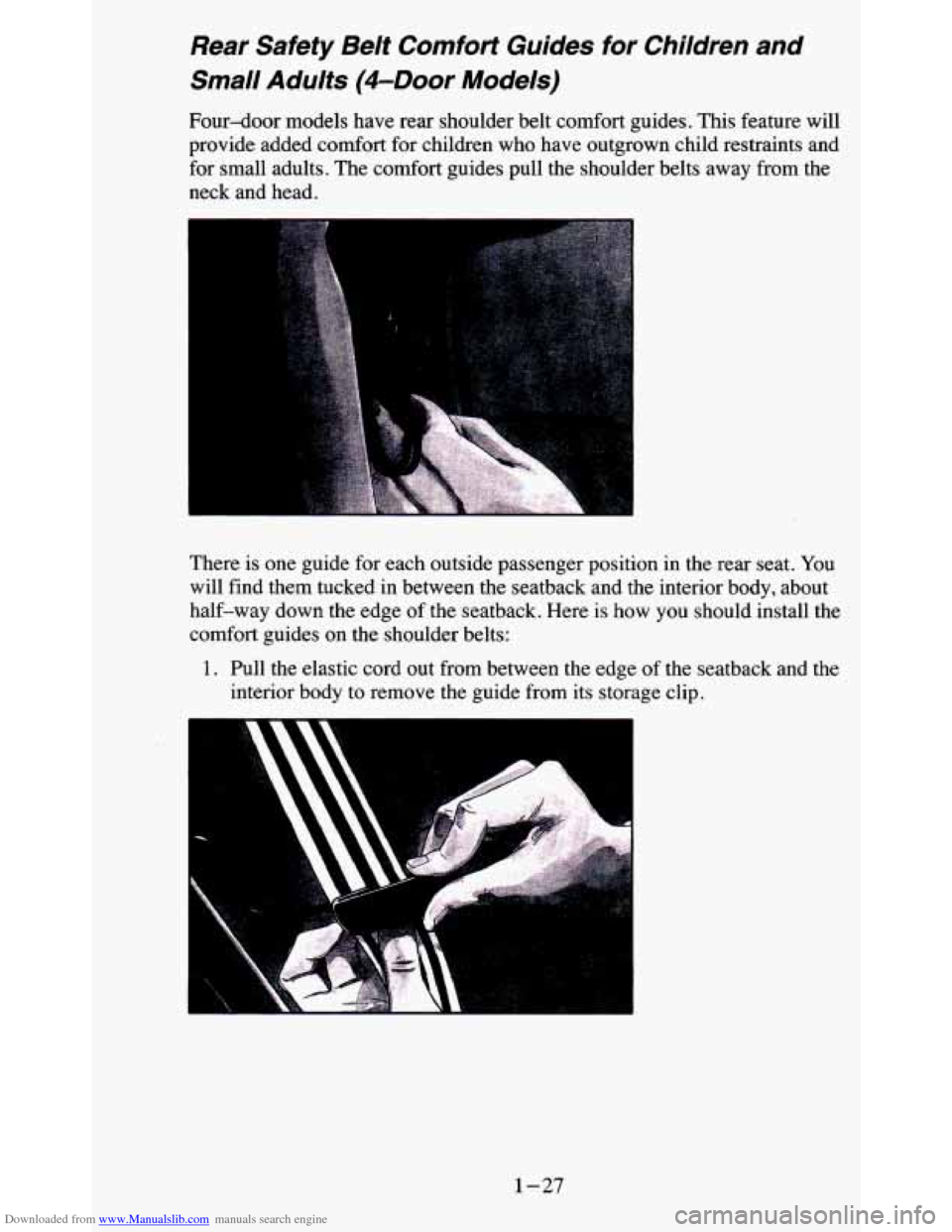
Downloaded from www.Manualslib.com manuals search engine Rear Safety Belt Comfort Guides for Children and
Small Adults
(&Door Models)
Four-door models have rear shoulder belt comfort guides. This feature will
provide added comfort for children who have outgrown child restraints and
for small adults. The comfort guides pull the shoulder belts away from the
neck and head.
There is one guide for each outside passenger position in the rear seat. You
will find them tucked
in between the seatback and the interior body, about
half-way down the edge of the seatback. Here
is how you should install the
comfort guides
on the shoulder belts:
1. Pull the elastic cord out from between the edge of the seatback and the
interior body to remove the guide from its storage clip.
1-27
Page 38 of 380
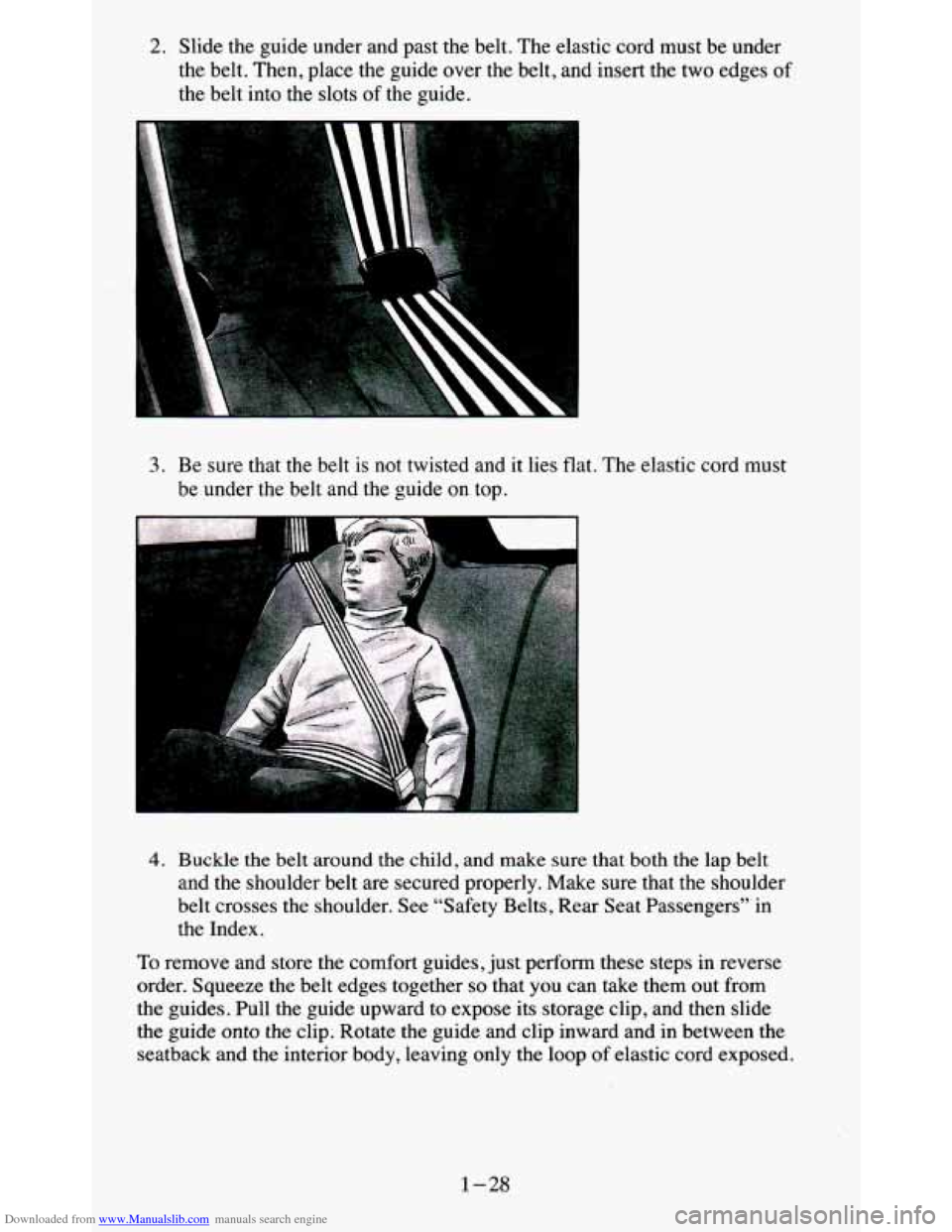
Downloaded from www.Manualslib.com manuals search engine 2. Slide the guide under and past the belt. The elastic cord must be under\
the belt. Then, place the guide over the belt, and insert the two edges of
the belt into the slots
of the guide.
3. Be sure that the belt is not twisted and it lies flat. The elastic cord must
be under the belt and
the guide on top.
4. Buckle the belt around the child, and make sure that both the lap belt
and the shoulder belt are secured properly. Make sure that the\
shoulder
belt crosses the shoulder. See “Safety Belts, Rear Seat Passengers” in
the Index.
To remove and store the comfort guides, just perform these steps in reverse
order. Squeeze the belt edges together
so that you can take them out from
the guides. Pull the guide upward to expose its storage clip, and then slide
the guide onto the clip. Rotate the guide and clip inward and in between the
seatback and the interior body, leaving only the loop
of elastic cord exposed.
1-28
Page 39 of 380
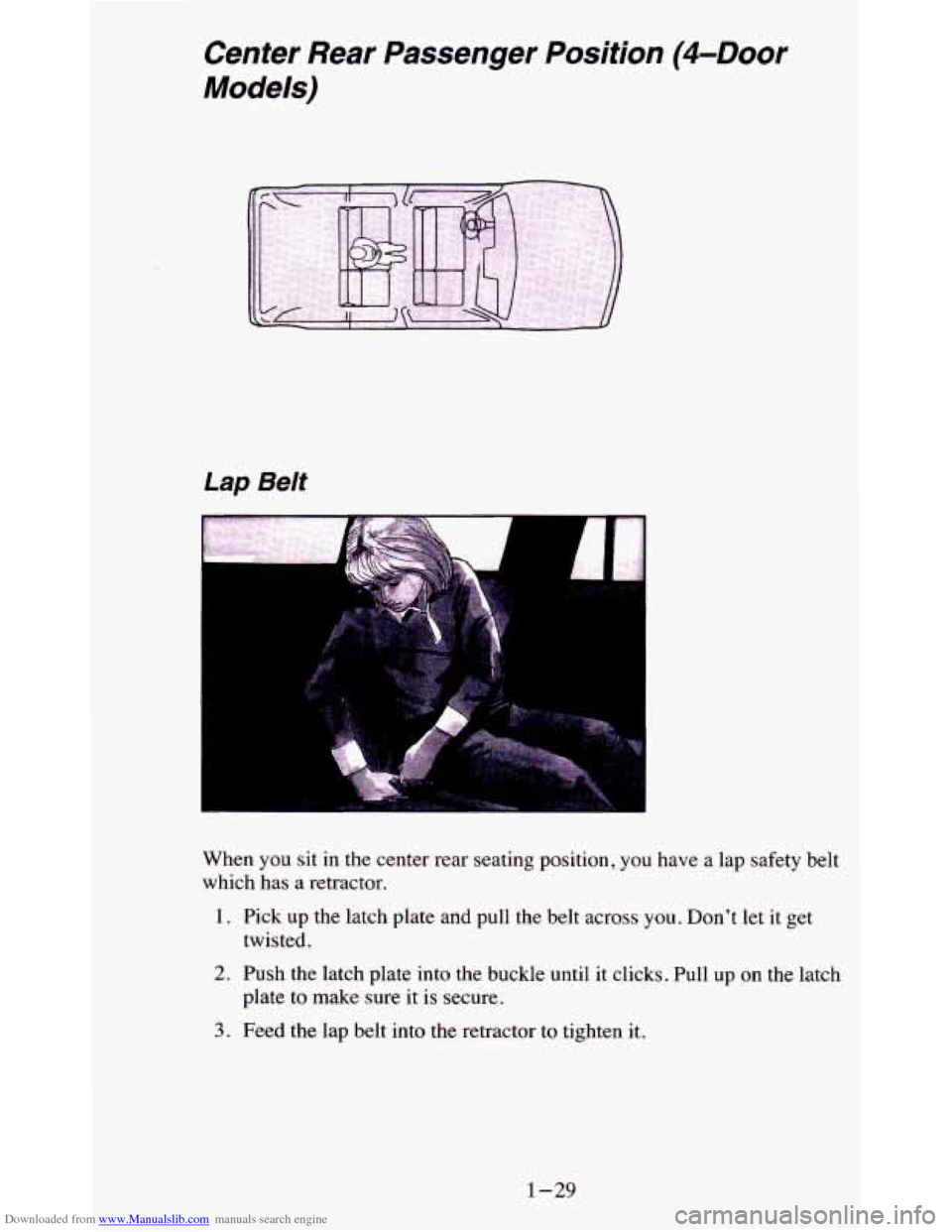
Downloaded from www.Manualslib.com manuals search engine Cenfer Rear Passenger Position (&Door
Models)
Lap Belt
I
When you sit in the center rear seating position, you have a lap safety belt
which has a retractor.
1. Pick up the latch plate and pull the belt across
you. Don't let it get
2. Push the latch plate into the buckle until it clicks. Pull up on the latch
3. Feed the lap belt into the retractor to tighten it.
twisted.
plate to make sure it is secure.
1-29
Page 40 of 380
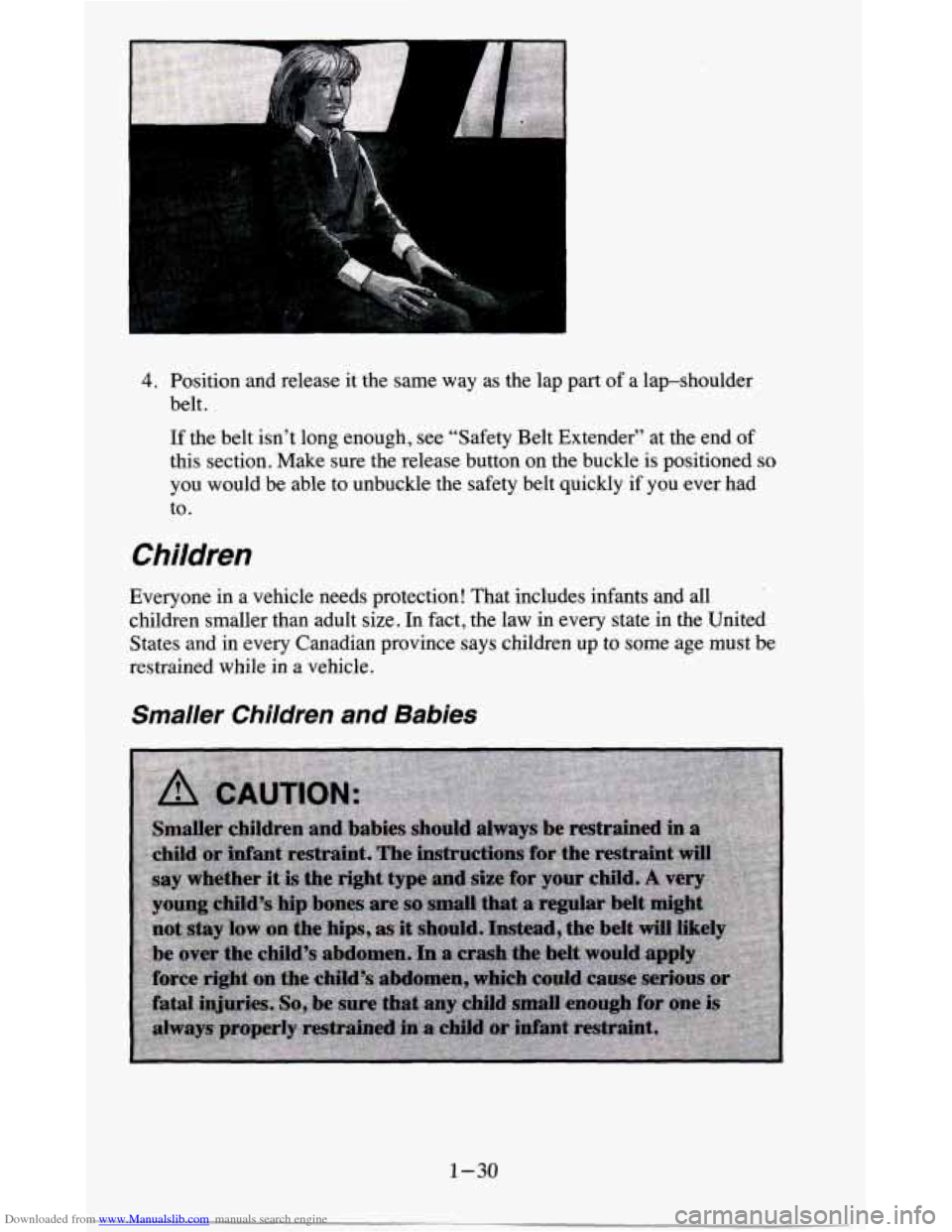
Downloaded from www.Manualslib.com manuals search engine 4. Position and release it the same way as the lap part of a lap-shoulder
belt.
If the belt isn’t long enough, see “Safety Belt Extender” at the end of
this section. Make sure the release button on the buckle is positioned so
you would be able to unbuckle the safety belt quickly if you ever had
to.
Children
Everyone in a vehicle needs protection! That includes infants and all
children smaller than adult size. In fact, the law in every state in the United
States and in every Canadian province says children
up to some age must be
restrained while in
a vehicle.
Smaller Children and Babies
1-30